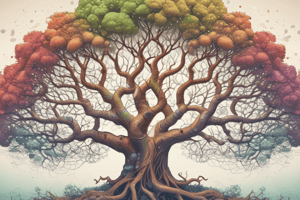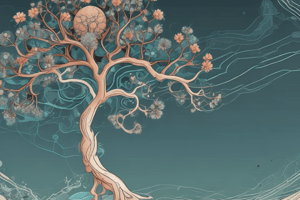Podcast
Questions and Answers
What is the primary function of the mitochondria in a cell?
What is the primary function of the mitochondria in a cell?
- To store genetic information
- To regulate cell growth and division
- To generate energy for the cell (correct)
- To facilitate cell-to-cell communication
Which of the following is NOT a type of biotic factor in an ecosystem?
Which of the following is NOT a type of biotic factor in an ecosystem?
- Light (correct)
- Animals
- Microorganisms
- Plants
What is the primary function of carbohydrates in living organisms?
What is the primary function of carbohydrates in living organisms?
- To store genetic information
- To regulate cell growth and division
- To facilitate cell-to-cell communication
- To provide energy and support cellular functions (correct)
Which branch of biology is concerned with the study of the structure, function, and evolution of cells?
Which branch of biology is concerned with the study of the structure, function, and evolution of cells?
What is the process by which new species emerge according to the theory of evolution?
What is the process by which new species emerge according to the theory of evolution?
What is the term for the relationship between two or more organisms in which one organism benefits and the other is harmed?
What is the term for the relationship between two or more organisms in which one organism benefits and the other is harmed?
Which of the following molecules is NOT a type of nucleic acid?
Which of the following molecules is NOT a type of nucleic acid?
What is the process by which cells generate energy from the food they consume?
What is the process by which cells generate energy from the food they consume?
Study Notes
Branches of Biology
- Botany: study of plants
- Zoology: study of animals
- Microbiology: study of microorganisms
- Ecology: study of interactions between organisms and their environment
- Genetics: study of heredity and variation
- Biochemistry: study of chemical processes in living organisms
- Molecular Biology: study of biological molecules and their interactions
Cell Biology
- Cell Structure:
- Cell membrane: separates cell from environment
- Cytoplasm: gel-like substance inside cell membrane
- Nucleus: contains genetic material
- Mitochondria: generates energy for cell
- Cellular Processes:
- Photosynthesis: process by which plants produce energy
- Respiration: process by which cells generate energy
- Cell division: process by which cells reproduce
Evolution
- Theory of Evolution: explains how species change over time
- Natural Selection: process by which organisms with favorable traits are more likely to survive and reproduce
- Speciation: process by which new species emerge
- Fossil Record: evidence of evolution through fossilized remains
Ecosystems
- Ecosystem Components:
- Biotic Factors: living organisms (plants, animals, microorganisms)
- Abiotic Factors: non-living components (light, temperature, water, soil)
- Ecosystem Interactions:
- Predation: relationship between predator and prey
- Symbiosis: relationship between two or more organisms
- Food Chains: series of organisms that eat other organisms
Biological Molecules
- Carbohydrates: energy-rich molecules (sugars, starches, cellulose)
- Proteins: molecules composed of amino acids (enzymes, hormones, structural proteins)
- Lipids: molecules composed of fatty acids (fats, oils, waxes)
- Nucleic Acids: molecules containing genetic information (DNA, RNA)
Branches of Biology
- Botany studies plants
- Zoology studies animals
- Microbiology studies microorganisms
- Ecology studies interactions between organisms and their environment
- Genetics studies heredity and variation
- Biochemistry studies chemical processes in living organisms
- Molecular Biology studies biological molecules and their interactions
Cell Biology
- Cell membrane separates the cell from the environment
- Cytoplasm is a gel-like substance inside the cell membrane
- Nucleus contains genetic material
- Mitochondria generates energy for the cell
- Photosynthesis is the process by which plants produce energy
- Respiration is the process by which cells generate energy
- Cell division is the process by which cells reproduce
Evolution
- The Theory of Evolution explains how species change over time
- Natural Selection is the process by which organisms with favorable traits are more likely to survive and reproduce
- Speciation is the process by which new species emerge
- The Fossil Record provides evidence of evolution through fossilized remains
Ecosystems
- Biotic factors include living organisms such as plants, animals, and microorganisms
- Abiotic factors include non-living components such as light, temperature, water, and soil
- Predation is the relationship between a predator and its prey
- Symbiosis is the relationship between two or more organisms
- Food Chains are series of organisms that eat other organisms
Biological Molecules
- Carbohydrates are energy-rich molecules including sugars, starches, and cellulose
- Proteins are molecules composed of amino acids and include enzymes, hormones, and structural proteins
- Lipids are molecules composed of fatty acids and include fats, oils, and waxes
- Nucleic Acids are molecules containing genetic information and include DNA and RNA
Studying That Suits You
Use AI to generate personalized quizzes and flashcards to suit your learning preferences.
Description
Explore the various branches of biology, including botany, zoology, microbiology, ecology, genetics, biochemistry, and molecular biology. Learn about cell structure and its components.




